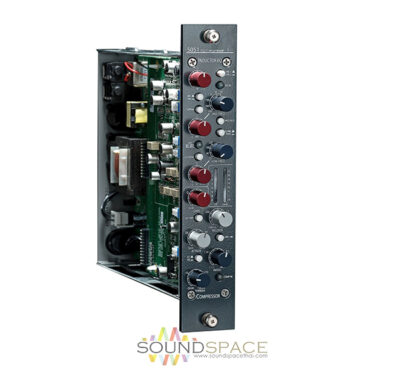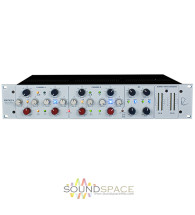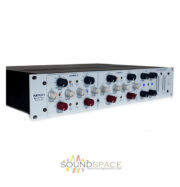Product Categories
- มิกเซอร์ (Mixer)
- ลำโพง (Speaker)
- เพาเวอร์แอมป์ (Power AMP)
- ไมโครโฟน (Microphone)
- ปรับแต่งเสียง (Signal Processor)
- บันทึกเสียง (Studio & Recording)
- • เครื่องบันทึกเสียงดิจิตอล (Digital Recorder)
- • โปรแกรมบันทึกเสียง (Software,Plug-in)
- • การ์ด คอนเวอร์เตอร์ (Card, Converter)
- • ออดิโออินเตอร์เฟส (Audio Interface)
- • ไมโครโฟน (Studio Microphone)
- • ไมค์ปรีแอมป์ (Microphone Preamp)
- • ลำโพงห้องบันทึกเสียง (Studio Monitor)
- • อุปกรณ์ปรับแต่งเสียง (Signal Processor)
- • หูฟัง (Headphone)
- • แอมป์ขยายหูฟัง (Headphone Amp)
- • อุปกรณ์เสริม (Recording Accessories)
- เครื่องเสียงพกพา (Portable)
- อุปกรณ์ ดีเจ (DJ Equipment)
Rupert Neve Designs Shelford 5051 Inductor EQ and Compressor
อีควอไลเซอร์,คอมเพรสเซอร์ Neve Shelford 5051 combines a classic 3-band EQ based on Rupert’s vintage designs with the power and flexibility of the Portico II compressor
ราคาไม่รวมภาษีมูลค่าเพิ่ม
฿135,000.00 ฿94,500.00
Description
Rupert Neve Designs Shelford 5051 Inductor EQ /Compressor
อีควอไลเซอร์,คอมเพรสเซอร์ Neve Shelford 5051 combines a classic 3-band EQ based on Rupert’s vintage designs with the power and flexibility of the Portico II compressor
The Rupert Neve Designs Shelford 5051 Inductor EQ and Compressor combines the classic 3-band EQ from Rupert Neve’s vintage circuit designs with the flexibility and power of the Portico II compressor. Using a fully discrete class-A signal path combined with high-performance input and output transformers, the combination EQ and compressor upholds the world renown reputation of the master circuit designer.
The EQ section
of the module uses a custom-tapped inductor with selected capacitors to form the mid-range equalizer band and the shelf curves are based on Neve’s vintage Modules. Each of the EQ sections uses a low feedback class-A discrete electronics to prevent low-level artifacts from distracting from the tonal shaping of your signal.
The high and low bands can be switched from shelf to peak curves and both offer 15 dB of boost or cut. The high band can be switched from 8,000 to 16,000 Hz and the low band can be set to 35, 60, 100, or 220 Hz. The mid band offers six center frequencies at 200, 350, 700, 1500, 3000, and 6000 Hz. The mid band also features a high peak switch to narrow the bandwidth or increase the Q of the filter. An 18 dB/octave high-pass filter with two corner frequencies that can be toggled between Off, 60, and 120 Hz.
The EQ can be switched to pre or post compressor in the signal chain. It also allows for the two XLR balanced inputs on the back of the unit to be switched from the front panel which allows setups such as having a mic preamplifier and a line input from a DAW to be pre-patched and selected at will.
The compressor section
of the module uses a discrete class-A signal path from the Portico Series of signal processors with individual control over threshold, attack, release, make up gain, ratio, side chain HPF, Feed-Forward/Feed-back selection and Peak/RMS detection modes. If you deactivate the compressor the unit can be used as a transformer-coupled high-performance line amplifier.
The compressor has the ability to switch between feed-forward and feed-back operation, and two modules can be linked together for stereo operation. The unit is intended for use with 5088 consoles or with 5285 vertical frames. There are two ±24V power supply options. One 5-way power supply can be placed at the bottom of the rack or a separate 25-way power supply in a 2U enclosure may be used. Using the external module provides clean power with less heat build-up within the modules associated with the DC to DC up-conversion.

- Classic Neve EQ Sound
- Compressor Design from Portico Series
- Discrete Class-A Circuit Design
- Selectable HF Shelf or Peak Filter
- Mid-Band Parametric EQ
- Side Chain High-Pass Filter
- EQ Before or After Compressor
- Feed-Forward/Feed-Back Operation
- Link Two Modules for Stereo Operation
- Two Ways to Power
Features
MIC GAIN
A 12-way precision rotary switch controls gain from 0 to 66 dB in 6 dB steps.
TRIM
Continuously variable +/-6 dB level control.
+48V
Engages phantom power on the microphone input, as supplied by the 500 series rack.
POLARITY
Push button inverts the polarity of the signal path, and illuminates when engaged. The symbol “Ø” is often used to denote opposite polarity.
HIGH PASS FILTER
The high pass filter is continuously variable from 20-250Hz and engaged by the HPF switch, which illuminates when engaged. It is a valuable aid in any signal chain, but particularly so in a microphone preamplifier. Signals below the selected frequency are attenuated at a rate of 12db / octave, getting rid of proximity effect, building rumble, air handling, motor hum, etc.
SILK / TEXTURE
Pushing the Silk button engages the red Silk circuit, which reduces the negative feedback on the output transformer, adding harmonic content as the texture is increased. Red Silk accentuates the saturation in the mid and high frequencies, similar to that of the red silk mode on the Portico II Channel. By manipulating the Texture control, the amount of Silk can be changed from essentially absent, to roughly 10 times the amount of coloration / distortion found in Silk from the original Portico Series. With Silk / Texture engaged, the distortion characteristic and harmonic content of the unit are very reminiscent of many of Rupert’s class-A vintage designs.
LEVEL METER
An Eight-segment LED bar-graph meter displays output level (pre-Silk). The color range proceeds from green for lower level signals, yellow for intermediate signals, and red for high levels. When the 511 is clipped, the highest red LED will hold longer depending on how far above the clip threshold the signal was.
Specifications
Rupert Neve Designs Shelford 5051 Inductor EQ /Compressor
| General | |
|---|---|
| Dimensions | Not specified by the manufacturer |
| Weight | Not specified by the manufacturer |



















